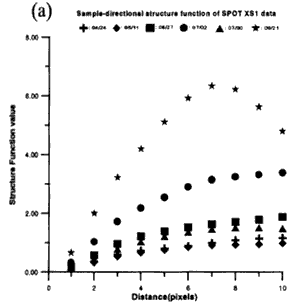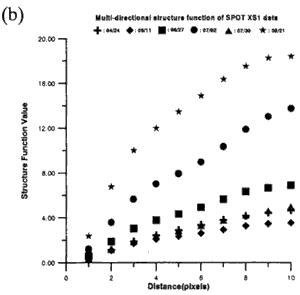| GISdevelopment.net ---> AARS ---> ACRS 1999 ---> Environment |
Applying SPOT Data to
Estimate the Atmospheric Aerosol Optical in Complex Terrain
Tang-Huang Lin*, A.j.
Chen** and Gin -Rong Liu**,
*Institute of Space Science, National Central
university Chung -li 320 , China Taipei
**Center for Space and rewmote sensing Research,
National Central University Chung -Li 320,
China Taipai
Email : grliu@csrsr.ncu.edu.tw
Keyword: Aerosol optical depth, structure
function, SPOT*Institute of Space Science, National Central
university Chung -li 320 , China Taipei
**Center for Space and rewmote sensing Research,
National Central University Chung -Li 320,
China Taipai
Email : grliu@csrsr.ncu.edu.tw
Abstract:
In applying the contrast method, such s the structure function method, to estimate the atmospheric aerosol depth with satellite data, a uniform land cover area in image in chosen as a test are to avoid the probable errors induced by the poor structure function patterns . unfortunately, the uniform are is not easy to pick up or does not exist in some complex land use regions, such as in Taiwan. In order to pursue the potential application of the structure function method, especially for complex terrain area, our study extends the original single-directional structure ;function to multi-directional, and introduces an " optimal number" in to our procedure to improve the accuracy; of aerosol depth estimation. The comparison between the estimated and sun photometer-observed aerosol depths shows that the accuracy is improved significantly by our improvements.
1. Introduction
Basically, satellite remote sensed data are affected mainly by the scattering effects of atmospheric molecular and aerosols in the visible band, Fraser et al., 1984.some atmospheric correcting schemes have been proposed in applying to the satellite visible band data, such as Landsat and SPOT images in the past studies ( Griggs, 1975; Mekler et al., 1977; Tanre et al., Rao et al., 1989; holben B.n. et.al., 1990 and Liu et al., 1997). Some studies showed that the structure function method can be used to estimate accurately the atmospheric aerosol depth, however obvious errors could be induced in same cases by the structure function patterns. Further analysis indicates that athe abnormal patterns probably are caused by the change of satellite observation geometry, the change or the complexity of land cover. Therefore , the aim of this study is to try to provide a solution reduce the probable errors in applying the structure method and improve the accuracy of optical depth estimation.
2.Methodology
Assuming the surface observed by satellite sensor is Lambertian , the apparent reflectance , ?*, observed by satellite is ( Tanre et al., 1988).

where ms= cosqs , qs is the solar zenith angle, msub>v= cosqv, qv is the observed zenith angle, pa is the atmospheric reflectance, f is the relative azimuth anlgle between the sun and the satellite, t is the optical depth, p is the surface reflectance, T is the transmittance from the sun to surface, s is the atmospheric albideo, <p> is the mean surface reflectance, and td is the diffused transmittance from surface to satellite.
The nulti-scattering effect of the surface and atmosphere is small and can be neglected. In other words, <?> s=0, Assuming the <?> values to be the same in local area, the apparent reflectance differences between two neighboring pixels , (I,j) ? (I, j+d), in distance d can be written as
??*(I,j) = ?? (I,j) T (ms) exp[-t/mv] (2)
where I, j are the row and column index of image, respectively. If we assume the ? (I,j) value being constant in time, the ?*(I,j) will be the function oft , which depends upon atmosphere condition. Tanre et al. (1988) has defined a structure function parameter, M, as

Where N is the total pixel number in the test are. In their original method, a single direction difference is calculated in the structure function. However , in our study, we consider a multi-directional( I, j and cross (c ) directions shown in Fig .1) structure function, which can be expressed as

and the structure function M* (d) derived by satellite observation can is written as
M*2 (d) =M2 (d) T2 (ms) exp [-2t/mv] (5)
Where M is the real surface structure function .
d=0 1 2 3 ...
| ?j | ||||
| ?i | ?c | |||
If assuming the land cover remaining unchanged from t1 to t2 observation time i.e. M2 (d,t1) = M2(d,t2) , the relationship of observed structure functions between t1 to t2 is,

Equation ( 6) shows that if one of the aerosol optical depth in t1 or t2 is known, the other optical depth can be derived from satellite observation.
Analysis shows that the estimated optical depth could be different for different d values. In this general cases, the mean value of optical depth from d=1 to d=10 is used, but significant errors could be observed in some cases when the correlation is low for different distances, so the " optimal number " is adopted to remove the abnormal structure function areas 9 Liu et al., 1997). The introduction of " optimal number can remove the poor structure functions and improve the accuracy of the optical depth estimation .
3. Data
This study used multi-temporal SPOT images to estimate the atmospheric aerosol optical depth. The data set includes 6 SPOT imageries acquired between April to August, 1998 covering Chung-Li area. The geometric information of the data set is shown in Table 1. meanwhile, the sun photometer data were collected at the same time. The aerosol depths derived from sun photometer data were used to verify the accuracy of the method proposed in this study ( Table 2).
| Date | Loc | View Angle | Solar Angle | ||
| al time | Zenith | Azimuth | Zenith | Azimuth | |
| 1998/04/24 | 02:23 | -29 | 193 | 24 | 117 |
| 1998/05/11 | 02:27 | -23 | 193 | 20 | 107 |
| 1998/06/27 | 02:24 | -30 | 193 | 21 | 89 |
| 1998/07/02 | 02:28 | -24 | 193 | 20 | 90 |
| 1998/07/30 | 02:59 | 31 | 193 | 15 | 110 |
| 1998/08/21 | 02:36 | -9 | 193 | 22 | 119 |
| Date | 1020nm | 870nm | 670nm | 440nm |
| 1998/04/24 | 0.133 | 0.157 | 0.249 | 0.470 |
| 1998/05/11 | 0.272 | 0.326 | 0.499 | 0.860 |
| 1998/06/27 | 0.125 | 0.141 | 0.215 | 0.418 |
| 1998/07/02 | 0.088 | 0.092 | 0.151 | 0.296 |
| 1998/07/30 | 0.159 | 0.175 | 0.259 | 0.478 |
| 1998/08/21 | 0.050 | 0.038 | 0.059 | 0.105 |
4. Result and Analysis
The singular structure function pattern are depicted in the Figure 2(a) . as mentioned previously, these poor structure functions are mainly caused by satellite observation geometry and complex land cover distribution. Therese patterns would induce further errors in the optical depth estimation. When multi-directional structure function is employed as illustrated in Fig 2(b), the improvement is evident.
 |
 |
| Figure 2(a) The varieties of the structure function with different distances of SPOT XS1 Channel .(b) same as (a), except for multi-directional structure function. | |
Further analysis showed the some abnormal patterns still existed in our approach. Therefore, the " optimal number " decision was added to determine the proper distance value, d and made sure that the abnormal structure function patterns can be removed.
The final result is summarized in Table 3. obviously, the accuracy of multi-directional method is better than the single-directional method, except on may 11 ( party cloudy ). The error is reduced from 33% to 9%. The result reveals improvement in accuracy derived from multi-directional method and the optimal number decision .
| Date | Sunphotometer measurements | Single-directional | Multi-directional | ||
| Retrieved | Error (%) | Retrieved | Error (%) | ||
| 1998/04/24 | 0.339 | 0.386 | 14 | 0.348 | 3 |
| 1998/05/11 | 0.647 | 0.394 | 39 | 0.374 | 43 |
| 1998/06/27 | 0.299 | 0.347 | 16 | 0.311 | 4 |
| 1998/07/02 | 0.209 | 0.277 | 33 | 0.228 | 9 |
| 1998/07/30 | 0.315 | 0.356 | 13 | 0.345 | 9 |
| 1998/08/21* | 0.078 | ------- | ----- | ------ | ------ |
5. Conclusions
The results strongly suggest that including multi-direction and optimal number in structure function method will greatly improve the accuracy of derived aerosol optical depth. In the further study, the relationship of test area size and distance values are necessary to be investigate in detail. In order to verify the accuracy of optical depth estimation, the accuracy and method of deriving optical depth from sun photometer observation is also an important task.
Acknowledgements
This work has been supported by grant form the National Science Council, China Taipei under NSC86-2612-E-008-007.
References
- Fraser B.C., Y.J. Kaufman , and R.L. Mahoney, 1984: Satellite measurements of aerosol mass and transport. Atm . Environment , 18(12). 2577-2584.
- Griggs M., 1975: Measurements of atmospheric optical thickness over water using ERTS-1 data . Journal Air Pollution Control Association. 25, 622-626.
- Holben B.N., Y.J. Kaufman, A. Setzer, D. Tenre', and D.E. Ward, 1990: Optical properties of aerosols from biomass burring in the tropics, BASE-A, Presented at e Chapman Conference on Biomass Burning. Williamsburg, VA, Mar., 1990.
- Holben B.N., E. Vermot , Y.j. Kaufman, D. Tenre, and V. Kalb, 1992: Aerosol retrieval over land form AVHRR data application for atmospheric correction. IEEE Trans. On Geoscience and Remote sensing, 30(2), pp.212-222.
- Kaufman Y.J., R.S. Fraser, and R.A. Ferrare, 1990: Satellite measurements of large -scale air pollution methods. J. Geophys, Res., 95(D7), 9895-9909.
- Liu C.H, A.J. Chen, and G.R. Liu, 1996: An image-based retrieval algorithm of aerosol characteristics and surface reflectance for satellite images. INT. J. Remote sensing , 17(17), 3477-3500.
- Liu G.R, T.H. Lin ,a dn A.J. Chen , 1997: An improved method to determine aerosol optical depth from SPOT data. COAA ' 97-First international Ocean -Atmosphere Conference, 18-19 Oct 1997, Washington , D.C., USA.
- Mekler Y.,H . Quenzel, G. Ohring, and I. Marcus, 1977; Relative atmospheric Aerosol content from ERTS observation .J. Geophys. Res., 82, 9868-972.
- Rao C.R.N., E.P. McClain, and C.C. Stowe, 1989: Remote sensing ofg aerosols over the oceans using AVHRR data theory. Practice and Application, INT.J. Remote Sensing , 10 (4-5), 743-749.
- Sifakis N.I., N.A.Soulkellis, and D.K. Paronis, 1998: Quantitative mapping of air pollution density using earth observations : a new processing method and application to an urban area. INT . J. Remote sensing , 19(17), 3289-3300.
- Tanre D., C. Devaux, M. Herman, R.Santer, and J.Y. Gac, 1988: Radiative properties of desert aerosols by optical ground-based measurements at solar wavelength. J. Geophys Res., 93. pp 14223-14231.